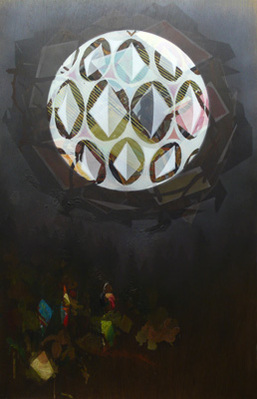
Hanging Object (Vision), 2008
oil, acrylic, and varnish on wood
36 x 23 in.
 Historical Elements, 2007
Historical Elements, 2007oil, acrylic, and varnish on wood
36.25 x 23.25 in.
Bob Matthews: Garden Ruin
by Jake Longstreth
June 13, 2009
Garden Ruin--the third exhibition at Gregory Lind Gallery for London-based artist Bob Matthews--reflects his continued exploration of the natural world, civilization and technology. In his previous two shows, Matthews presented pictures in the form of "digital drawings" and "digital Cibachromes." Those glossy, computer-generated images revealed an assured, aseptic approach to landscape, complicating their depiction of natural, lived-in spaces.
In Garden Ruin, he has taken a decidedly more organic and abstracted approach in presenting four oil and acrylic paintings on panel, three ink jet prints, and one lithograph. Matthews' adventuresome aptitude across different media suggests a restless fascination with the encounters between artistic materials and content: how they conflict and alter our understanding of one or the other. This exploration, in fact, seems to be the core of the show.
His paintings in oil and acrylic make the most of the inherent qualities of each medium. In works such as Historical Elements (2007) and Hanging Object (Vision) (2008), thick dabs of old-looking oil paint are applied in a scattershot manner. Nearby, hard-edged, flat acrylic paint is used to describe more definitive forms: discs, orbs, wires, and wind chimes. An engaging tension is found between the atmospheric, hand-made effect of the oil paint and the hard-edged exactitude of the bright and opaque acrylic forms. Through exploring the essences and historical resonances of different media--in pitting them against each other on the same panel--one begins to see the wood grain and oil paints as stand-ins for the organic, natural world while the plasticity of hard-edged acrylics becomes symptomatic of our technologically inundated social condition. I didn't take the works to be necessarily "about" humankind vs. the natural landscape. Indeed, very little of this content is directly addressed. Rather, the works seem concerned with the potential for imbuing different artistic media with specified, metaphorical meanings around this conflict.
At times, Matthews seemed burdened by an excess of content. One senses a struggle to communicate a coherent thesis that extends past the parameters of these oblique, abstract works. The various garden signifiers scattered throughout--most notably images of wind chimes--tend to function as obligatory signposts, reminders that we are to keep the garden space in mind. Consequently, these elements feel superimposed and slightly illustrational. The strong aspects of Matthews' work seem to address far more indefinite, broad historical themes than the hermeneutic of this project allows. Contemplative and imbued with a dour beauty, Matthews' work remains anchored within its own confines, but with an eye out there, on a larger world.